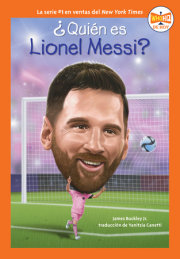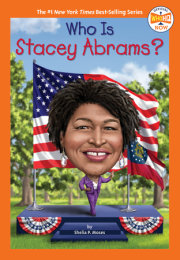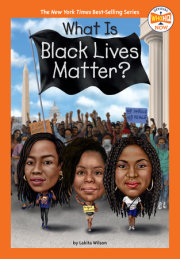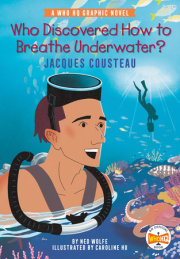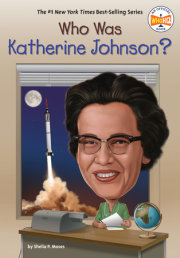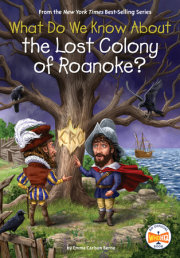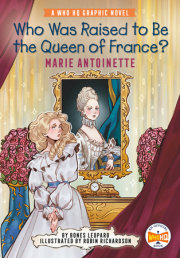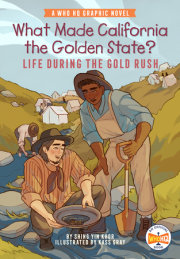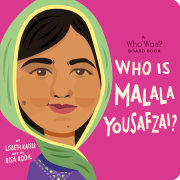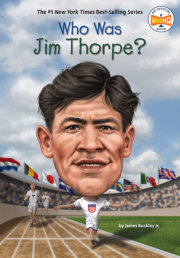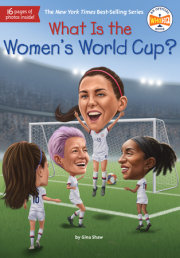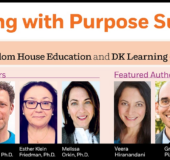Who Is Megan Rapinoe? The pressure was on as the United States Women’s National Team (USWNT) took the field on June 28, 2019, for the FIFA Women’s World Cup quarterfinal against France. The US team entered the tournament ranked number one in the world, after going undefeated in seventeen matches in the year leading up to this World Cup. But France had broken the Americans’ unbeaten streak with a 3–1 win in a friendly match in January. Now, they’d play again with a semifinal spot at stake.
With her pink hair, easy smile, and wicked goal-scoring abilities, American striker Megan Rapinoe had become one of the fan favorites of the USWNT as the Americans blazed through the tournament. Megan had scored two exciting goals to power her team through their round of sixteen matches against Spain. And now, she was determined to help bring them into the semifinals.
The Parc des Princes stadium in Paris was packed to capacity with more than forty-five thousand people as Megan put the Americans ahead in the fifth minute with a free-kick goal from twenty-two yards out. The ball snuck through the legs of the players jostling in front of the goal and slotted neatly into the corner. Even though France was the host nation, American fans filled the stands, and as they roared to celebrate the goal, Megan proudly spun toward the fans and threw open her arms with a wide grin on her face in a now-famous pose.
But Megan wasn’t done. She struck again when Tobin Heath sent the ball rocketing to an onrushing Megan, who scored from eight yards out! That put the US up 2–0. And even though the French would score on a free kick in the eighty-first minute, they never caught up. At the final whistle, Megan and her teammates celebrated wildly. Megan’s goals had sent them to the semifinals!
The triumphant pose Megan struck after her first goal against France became known as her power pose, and it appeared everywhere in photos and news articles about the Americans’ big semifinal win over the host nation. It was printed on posters, mugs, and T-shirts. As the US Women’s National Team rolled to a gold medal in the World Cup, this bold lesbian striker with a big personality and an air of fearlessness both on and off the pitch would transcend her sport to become known as an activist and a legend.
Chapter 1: Young Megan Megan Rapinoe and her twin sister, Rachael (fraternal twins do not look alike), were born on July 5, 1985, in Redding, California. The twins were the youngest of six children, and they were inseparable. They spent their childhood running around the empty field across from the house, riding bikes, playing hide-and-seek and laser tag, and catching crawdads at the nearby creek.
The girls particularly looked up to their older brother Brian, who played soccer. They wandered the sidelines at Brian’s practices, watching and copying his moves. At age six, they joined a boys’ Under-8 soccer team because there were no girls’ teams close by. The twins didn’t mind. They loved soccer, and they happened to be naturally good at it. Megan and Rachael dominated the boys on their team, playing so well that their coach declared to their parents, Denise and Jim, “They’re going to be in the World Cup one day!”
The Rapinoe twins’ secret? Even though they were best friends, they were also each other’s biggest rivals, and they got better by challenging each other. Every day after school until sunset, the twins practiced their soccer skills in the yard or at a nearby soccer field.
But off the soccer field, the girls were very different. Megan was a goofball with a knack for doing funny impressions of people, while Rachael was quiet and more serious. By sixth grade, Rachael was very social and had lots of friends, while Megan considered herself a tomboy who didn’t quite fit in. She counted on Rachael to help her.
The twins played on boys’ soccer teams until they were ten. Then their father started a girls’ team that he coached for a few years. After that, the twins were invited to join the competitive Elk Grove club soccer team, based in Sacramento, about a two-hour drive south of their home. So every weekend morning until the twins were about seventeen, Denise and Jim packed the girls into the family minivan at 4 a.m. to take them to Sacramento for practices or games. The twins embraced this busy life because by this time they were both soccer fanatics. And the 1999 FIFA Women’s World Cup only fed that fire.
The 1999 Women’s World Cup was the third edition of the tournament and the first to be played in the United States. Megan and Rachael watched the games on television, thrilled to see their favorite sport being played in front of thousands of cheering people. The sisters even got to see the US beat Brazil in person when they attended the semifinal game at Stanford Stadium. Amid an exciting atmosphere, the US won 2–0 and advanced to the final.
Watching the team’s journey to its second World Cup title after beating China in the finals made a huge impression on Megan. She and Rachael were just two of the thousands of girls who idolized the USWNT stars after the World Cup. That summer, Megan and Rachael put up a poster of the Women’s National Team on their bedroom wall. They dreamed of playing college soccer, but Megan never imagined that she might one day be featured in a similar poster wearing the red, white, and blue jersey of the US national team.
Chapter 2: College and Early Days with the National Team By their senior year of high school, Rachael and Megan were being recruited by many colleges to play soccer. None of the schools really felt “right” until they visited the University of Portland, in Oregon, in fall 2003. The Portland Pilots had won a national championship in 2002. Also, the twins liked the school and the city, and they felt like they fit in with the team. They accepted full scholarship offers to the University of Portland and planned to start their freshman year of college there in September 2004.
Then, Megan got a phone call. The coach of the US Women’s National Team wanted her to represent the US in the FIFA Under-19 Women’s World Championship in Thailand. (FIFA is the governing organization for soccer worldwide.) Megan was stunned that the national team was even aware of her!
So in fall 2004, the twins separated for the first time, each happy for the other but excited to begin her own journey. Rachael started college in Portland, while Megan deferred (put off) college for a term to play with the U-19 national team.
Megan scored three goals in the U-19 Women’s World Championship series. Over three weeks in Thailand, she played in front of international fans and befriended players such as Ashlyn Harris and Becky Sauerbrunn, who became lifelong friends. Megan had gotten her first taste of life as a professional soccer player (someone who is paid to play soccer), and she wanted more. Could she make the national team in time for the 2007 FIFA Women’s World Cup or the 2008 Olympics?
But first, Megan joined Rachael in college, enrolling at Portland in January 2005 and instantly becoming one of the Pilots’ stars. Portland went undefeated during the 2005 season and won its second national championship in four years. Megan started every game that season and scored fifteen goals. She finished her first season of college soccer as an All-American and was named the Soccer Times National Freshman of the Year.
Living away from home for the first time also helped Megan get to know herself in a different way. A few weeks into freshman year, Megan developed a crush on one of her teammates. As she explored her emotions, she realized she was gay. “For the first time, I was attracted to someone, and the discovery thrilled me,” Megan wrote in her autobiography. She rushed out to share the news with Rachael. And her response was simply: “Oh, me too.” Once again, the twins realized they were so in tune that they couldn’t surprise each other!
College wasn’t all rosy for Megan, however. Expectations were high after her successful freshman year—especially after she finished training camp with the US senior national team. At camp, she shared a locker room with national team greats like Kate Markgraf, and also Kristine Lilly, whom she remembered cheering on during the 1999 Women’s World Cup. Megan couldn’t believe she was now on their team! She did well in camp and played in two international friendly matches afterward. But in a game for Portland that fall, Megan injured her left knee. The diagnosis was a torn anterior cruciate ligament (ACL), and the doctor told Megan she would need surgery and that her sophomore season was over.
After surgery, Megan worked hard in physical therapy to strengthen her knee and pushed herself relentlessly, trying to beat the doctor’s estimates and get back on the field faster. She was cleared to play again to start her junior year, only to repeat the same injury in practice a few weeks into the season. For the second time in a year, Megan had surgery on her left knee. When she woke up in bed after this second surgery, her mom said gently, “You know, Megan, it’s not the end of the world. You still have your college scholarship, and you’ve achieved great things already.” But Megan refused to believe that knee problems might have ended her promising soccer career. “Mom, I’m not done,” she said.
Her determination paid off. Megan forced herself to be more patient with her recovery. She followed her doctor’s orders. And she trained for about a year and a half without playing in any games. Megan returned to competition in the Pilots’ 2008 season opener against Oregon that August, notching two assists. It was the start of a great season for Portland, which won nineteen straight games before losing in the semifinals of the national tournament.
After graduating from college, Megan was drafted by the Chicago Red Stars, a team in the new Women’s Professional Soccer (WPS) league, in which teams in different American cities play one another. She moved to Chicago that March, thrilled that playing soccer was now her job!
Copyright © 2023 by Penguin Random House LLC. All rights reserved. No part of this excerpt may be reproduced or reprinted without permission in writing from the publisher.









